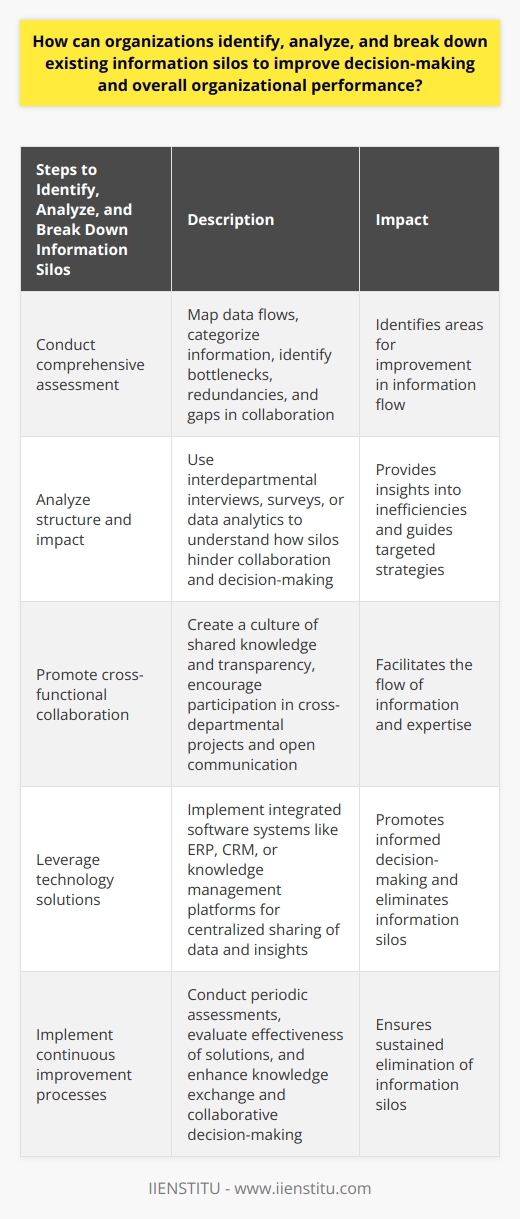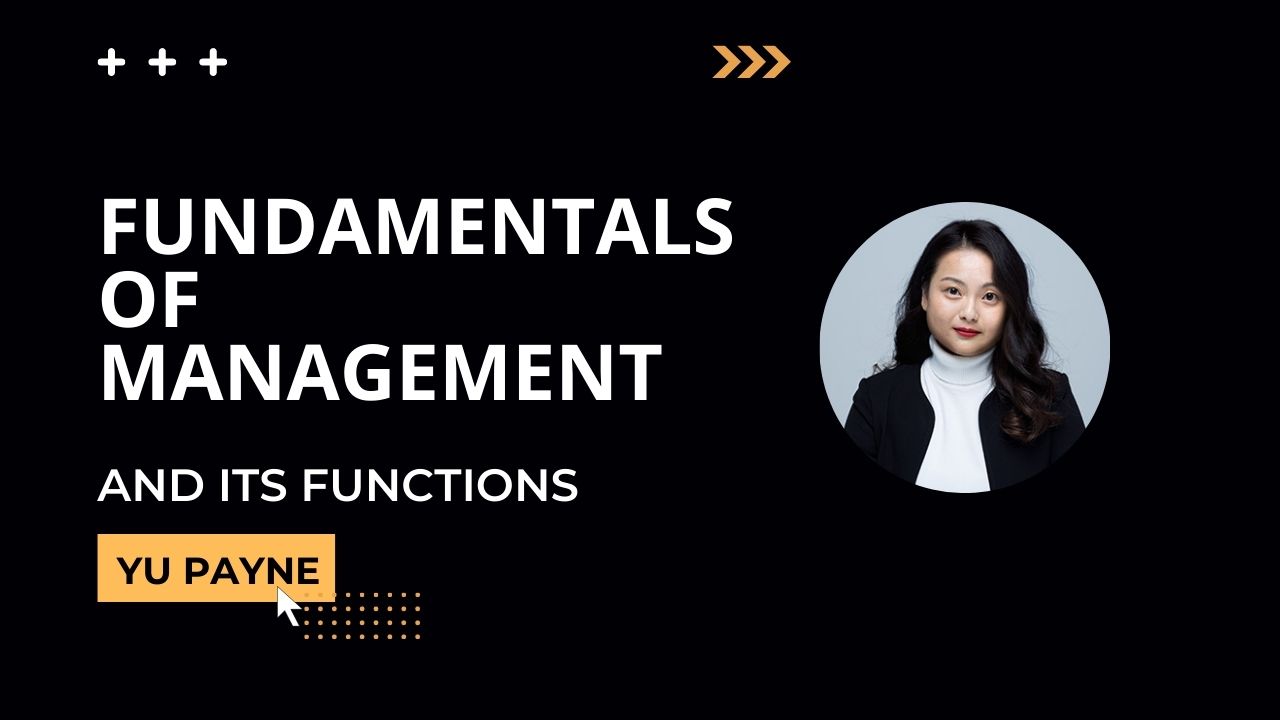
Overcoming Silos
Avoiding Interference
Product leadership is the process of planning, launching, and supporting the development of profitable products. A successful product leader drives the product vision and contributes to the success of an organization both from an operational and strategic standpoint. In addition, product leaders are tasked with developing profitable products and ensuring their sustainability and customer satisfaction.
Related Course: Leadership Course Online
Though product leadership can be rewarding and challenging, it often involves navigating through a range of obstacles and constraints - one of which is the presence of organizational silos and interference. This blog will explore how those in the product leadership role can overcome these challenges.
Overcoming Silos
Organizational silos refer to divisions between departments or areas of expertise. This is often caused by an organization’s desire to streamline its processes. However, it can hurt the product development process. Silos can lead to communication and coordination challenges, resulting in inefficiencies and delays in product launches.
To break down silos, it is essential to have an open and collaborative culture in which everyone feels comfortable communicating their ideas and sharing information. This can be achieved through effective communication strategies and regular meetings between teams and departments. Additionally, creating a wide array of cross-functional teams can help to break down existing silos and promote collaboration.
Avoiding Interference
Another challenge that product leaders face is interference from external factors, such as stakeholders and customers. These external influences can be detrimental to the product development process. For example, they can lead to delays, changes in strategy, and dissatisfaction with the final product.
To minimize external interference, it is essential to communicate the goals of the product development process and the strategies that will be used to achieve them. This helps ensure that external parties are adequately consulted and their opinions are taken seriously. Establishing a structure and process that allows feedback from stakeholders, customers, and other key players to be collected and addressed efficiently is essential.
Conclusion: Product leadership is a challenging yet rewarding role. It involves developing successful products and navigating the challenges of organizational silos and external interference. By implementing the strategies outlined above, those in the product leadership role can more effectively manage these challenges and ensure the success of their product.
Successfully fulfilling the product leadership role requires understanding the challenges that come with the position and the strategies needed to address them. For example, product leaders must try to break down silos and minimize interference from external parties to ensure the product development process is efficient and effective. Additionally, robust communication and collaboration strategies can help smooth the process and increase customer satisfaction.
Effective product leadership requires vision, collaboration, and the courage to overcome internal silos and outside interference.

Frequently Asked Questions
What strategies are most effective for a product leader at breaking down silos and ensuring inter-departmental communication?
Product leaders should actively pursue measures to accelerate inter-departmental communication, in order to not just restrict the opportunities for collaboration, but also to break down silos and create a more cohesive working environment. Such strategies are, however, challenging to both formulate and implement. This article will understand what strategies help effectively break down silos and ensure inter-departmental communication.
Firstly, product leaders should create and promote a culture of trust. Inter-departmental collaboration and communication will benefit from a culture in which teams trust each other and understand that their shared goals will lead to a successful outcome. This trust should be promoted through regular meetings and activities that foster team building, emphasizing the importance of communication and collaboration between departments. Product leaders can also create an environment that encourages team members to communicate, socialize and learn from each other, so as to promote greater inter-departmental understanding, mutual respect and cooperation.
Secondly, product leaders should devise plans and strategies that will enable inter-departmental communication. This could include regular meetings, presentations and events to enable the sharing of ideas and knowledge, and ensure smooth operations between the departments. Product leaders should also develop systems for digital communication and collaboration, such as an enterprise social media or communication platform, so that departments can interact with each other quickly and easily, as well as with other external bodies.
Thirdly, product leaders should also implement organizational policies to enable open communication. Policies such as flexible working hours, telecommuting, and open office layouts will contribute to both productive and collaborative working environments. Leadership should also create a culture that allows for both direct and indirect communication, emphasizing the importance of transparency and honesty. Through such measures, teams can better understand each other’s needs, collaborate and communicate better.
Finally, product leaders should ensure that teams have access to training and resources to ensure effective communication and collaboration. Training should emphasize the key terms, concepts and processes that are necessary for successful collaboration, while access to resources should enable teams to understand how best to use them.
In conclusion, product leaders should actively pursue measures to accelerate inter-departmental communication, in order to break down silos and create a more cohesive work environment. Such strategies should include creating a culture of trust, devising plans and strategies that will enable inter-departmental communication, implementing organizational policies to enable open communication and providing access to training and resources.
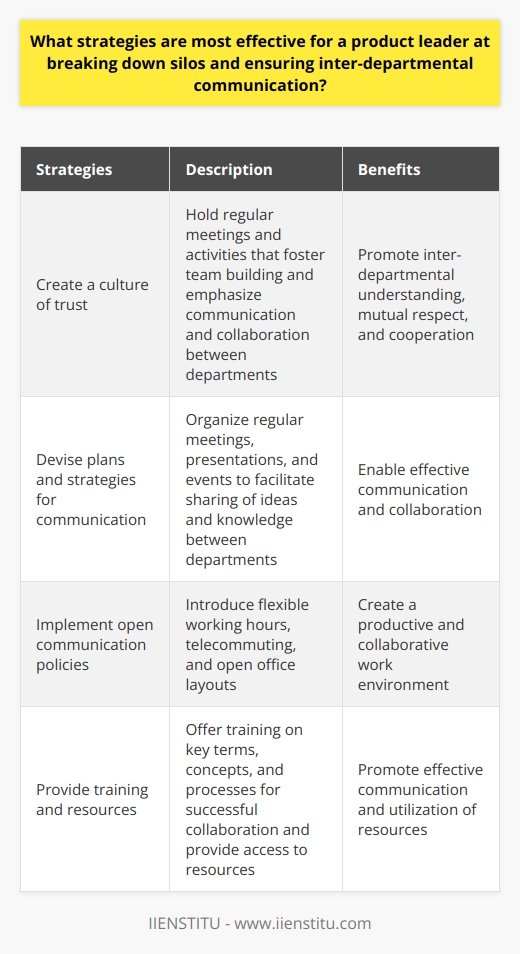
How can a product leader ensure that they convey the product's mission and desired tone of voice in a consistent manner?
.
Ensuring a consistent mission and tone of voice for a product can be challenging for product leaders. In order for product leaders to be successful in this area, there are a few key steps to ensure the consistent delivery of a product's mission and desired tone of voice.
First and foremost, it is important to clearly define the mission and tone of voice associated with the product. Product leaders need to ensure that everyone involved in the product is aware of the product's mission, goals, and desired tone of voice. This may involve having an open discussion to solicit feedback and create clarity around the overall vision, mission, and desired tone. Additionally, it is important to set expectations and guidelines, establish metrics to measure success, and provide ongoing training and support.
Second, product leaders need to ensure the consistent implementation of the product's mission and tone of voice throughout all aspects of the process. This includes product design, promotion, and customer interactions. Product design should adhere to the product's mission and desired tone of voice. To ensure consistency, product leaders should create a framework that outlines the design decisions that need to be made. Additionally, promotion should reflect the product's mission and desired tone of voice. The tone for customer interactions should also reflect the product's mission and desired tone of voice.
Third, product leaders need to create a culture that supports the consistent implementation of the product's mission and tone of voice. This includes making sure that everyone working on the product is aware of the product's mission, goals, and desired tone of voice. Additionally, product leaders should provide incentives and rewards for employees who exemplify the product's mission and tone.
Ultimately, product leaders need to ensure a consistent mission and tone of voice for their product in order for it to be successful. Through the creation of a plan and a culture that encourages the consistent implementation of the product's mission and desired tone of voice, product leaders can ensure the successful delivery of their product to their target market.
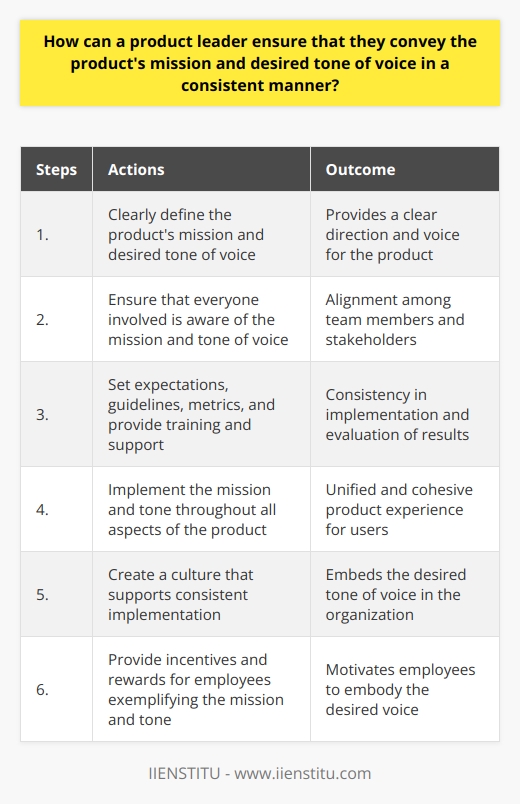
What methods can a product leader use to promote collaboration and productivity between teams of different sizes and expertise?
Product leaders are often tasked with the challenge of promoting collaboration and productivity between teams of different sizes and expertise. The goal is to reduce friction between teams, maximize their efficiency and ensure the successful delivery of projects. To reach this objective, product leaders can use several methods that are based on team dynamics, communication, and problem solving.
Team dynamics methods include giving team members individual tasks and roles, training team members to work together effectively, fostering an atmosphere of collaboration, ensuring teams are not too big or too small and deploying the proper leadership framework to manage teams. Communication methods focus on clear expectations and objective analysis, staying focused on the project’s goal, encouraging open dialog, and incorporating feedback from team members. Finally, problem-solving methods aim at resolving differences of opinion through creativity, open group discussions, and creating a sense of ownership and accountability regarding project decisions.
Effective product leadership focuses on strengthening team dynamics, fostering collaborative communication and creating problem-solving frameworks. It is also important to understand the strengths and weaknesses of teams of different sizes and expertise and adjust the techniques used to fit the team's needs. Product leaders should strive to create an atmosphere of trust and respect that allows team members to make the most of their strengths and explore their creative potential.
In summary, successful collaboration and productivity among teams can be achieved when product leaders have a thorough understanding of team dynamics, communication, and problem-solving. When product leaders capitalize on team strengths and weaknesses, promote collaborative communication, and create frameworks for creative problem-solving, teams of different sizes and expertise will be able to work together effectively and move projects forward.
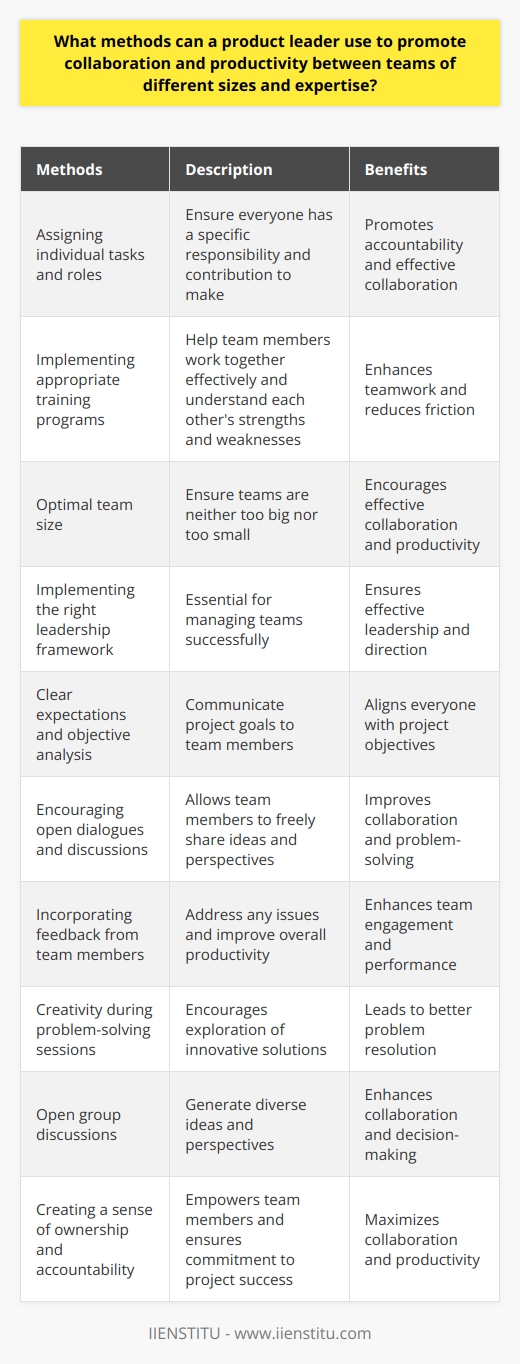
How can a collaborative culture be cultivated within an organization to effectively dismantle silos and enhance interdepartmental cooperation?
Fostering a Collaborative Environment
To cultivate a collaborative culture within an organization and effectively dismantle silos and enhance interdepartmental cooperation, it is essential to adopt certain strategies and practices. These strategies will help in promoting open communication and encourage involvement among employees from different departments, enabling them to work together effectively.
Establishing Open Communication Channels
First and foremost, it is vital to establish open communication channels within the organization. These channels may include regular meetings, online platforms, and informal gatherings. Providing opportunities for employees to consistently share their ideas, challenges, and achievements encourages networking and fosters dialogue across various departments.
Encouraging Teamwork Through Shared Goals
Next, it is essential to encourage teamwork by setting shared goals and objectives. Aligning the goals of different teams and departments within the organization ensures that everyone is working towards a common purpose. This approach not only breaks down silos but also helps to reduce competition and conflicts among teams, fostering a spirit of collaboration and mutual support.
Facilitating Cross-Functional Projects
Another effective way of cultivating a collaborative culture is by facilitating cross-functional projects. These projects involve team members from different departments working together to achieve a common objective. Through this process, employees can leverage their diverse skills and perspectives, fostering a sense of unity and collaboration. This interaction also helps to break down departmental barriers and develop stronger professional relationships.
Offering Collaboration Tools and Training
To further enhance collaboration, it is crucial to provide employees with the necessary tools and training. This can involve implementing project management software, offering training sessions on effective communication and conflict resolution techniques, and providing resources to promote collaborative learning. Equipping employees with these tools and skills enables them to efficiently work together and fosters a culture of cooperation.
Recognizing and Rewarding Collaboration
Lastly, it is essential to recognize and reward instances of successful collaboration. Celebrating team successes and acknowledging outstanding collaborative efforts inspire employees to continue engaging in cooperative behavior, contributing to a sustainable collaborative culture. Establishing a reward system that incentivizes collaboration helps to reinforce the value of working together and ensures continued interdepartmental cooperation.
In conclusion, cultivating a collaborative culture within an organization to dismantle silos and enhance interdepartmental cooperation necessitates the adoption of various strategies. Establishing open communication channels, encouraging teamwork through shared goals, facilitating cross-functional projects, offering collaboration tools and training, and recognizing and rewarding collaboration are all essential strategies for fostering a cooperative and productive work environment.
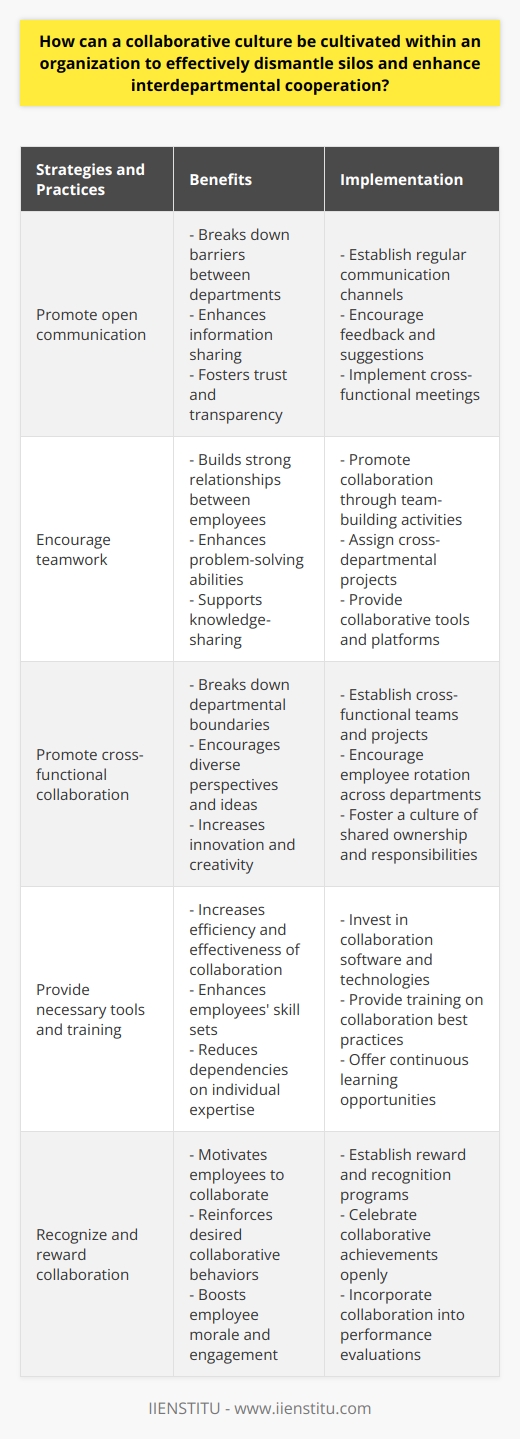
What approaches can be implemented by those in leadership positions to promote cross-functional teamwork and diminish organizational silos?
Promoting Cross-Functional Teamwork
To promote cross-functional teamwork and diminish organizational silos, leaders must first foster open communication channels within the organization. Encouraging the use of collaborative tools and platforms to facilitate discussions across different teams can significantly improve cross-functional interactions. Creating company-wide initiatives that encourage collaboration can also enable employees to work together towards common goals.
Creating Opportunities for Shared Learning
One efficient approach is to provide opportunities for shared learning among employees with diverse expertise. Training sessions, workshops, and seminars can be organized to bring together individuals from various functional areas. These learning exchanges can help break down barriers between departments, drive innovation, and create synergies among cross-functional teams.
Developing a Common Language
Another technique to reduce silos includes adopting a common language that unifies different teams under the same organizational identity. For example, leaders can design processes that center around the concept of shared or customer-centric values, while using a shared terminology that resonates with employees from all departments. This alignment encourages teams to work together and utilize their collective knowledge to achieve organizational objectives.
Setting Collaborative Goals
In addition, leaders can facilitate cross-functional teamwork by developing cooperative goals that call for cooperation and joint problem-solving. Collaborative objectives drive cross-departmental interactions and make individuals accountable for shared outcomes. By aligning individual interests with organizational concerns, leaders can encourage inter-departmental coordination, eliminate conflicts, and improve overall teamwork.
Encouraging Employee Exchange Programs
Lastly, employee exchange programs can provide first-hand experience of working with different teams, exposing employees to new skills and facilitating knowledge transfer. By temporarily assigning employees to other departments, leaders can ensure a better understanding of the broader organizational goals and foster the development of cross-functional relationships.
In summary, leaders should prioritize open communication, create opportunities for shared learning, adopt a common language, develop collaborative goals, and enable employee exchange programs. Implementing these practices can support the development of cross-functional teamwork, leading to increased innovation, enhanced productivity, and diminished organizational silos.
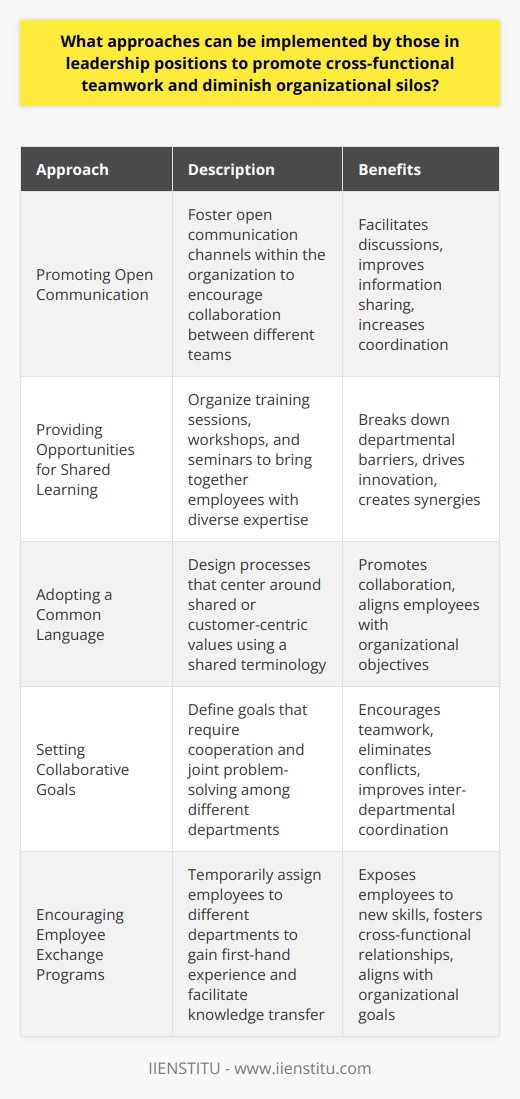
How can organizations identify, analyze, and break down existing information silos to improve decision-making and overall organizational performance?
Identifying Information Silos
Organizations can start by conducting a thorough assessment of their existing information systems, processes, and communication channels. This process must involve mapping out data flows, categorizing information types, and identifying any bottlenecks, redundancies, or gaps in collaboration.
Analyzing the Silo Structure
Upon identifying the silos, a comprehensive analysis should be performed to understand their impact on decision-making and overall performance. Certain tools and methodologies, such as interdepartmental interviews, surveys, or data analytics, can provide valuable insights into the existing inefficiencies and areas for improvement.
Breaking Down the Barriers
To dismantle information silos, organizations can adopt cross-functional collaboration and open communication channels, promoting a culture of shared knowledge and transparency. Encouraging team members to participate in cross-departmental projects, communicate openly through appropriate platforms, and share their knowledge and expertise can help build a cohesive and efficient organization.
Leveraging Technology Solutions
Organizations can also use technology to facilitate information-sharing and improve decision-making. Introducing integrated software systems like Enterprise Resource Planning (ERP), Customer Relationship Management (CRM), or knowledge management platforms ensures that data and insight are available to all relevant stakeholders within the organization, thereby promoting informed decision-making.
Periodic Assessments and Continuous Improvement
It is crucial for organizations to periodically reassess their internal communications, data flows, and workplace culture to ensure the elimination of silos remains effective. This ongoing process should identify any new silos, evaluate the effectiveness of implemented solutions, and determine how elements like the exchange of knowledge, shared goals, and collaborative decision-making can be further enhanced.
In conclusion, organizations can identify, analyze, and break down existing information silos by thoroughly assessing internal systems and communication channels, fostering a culture of collaboration, leveraging technology solutions, and implementing periodic assessments for continuous improvement. These strategies will collectively contribute to improved decision-making and overall organizational performance.
